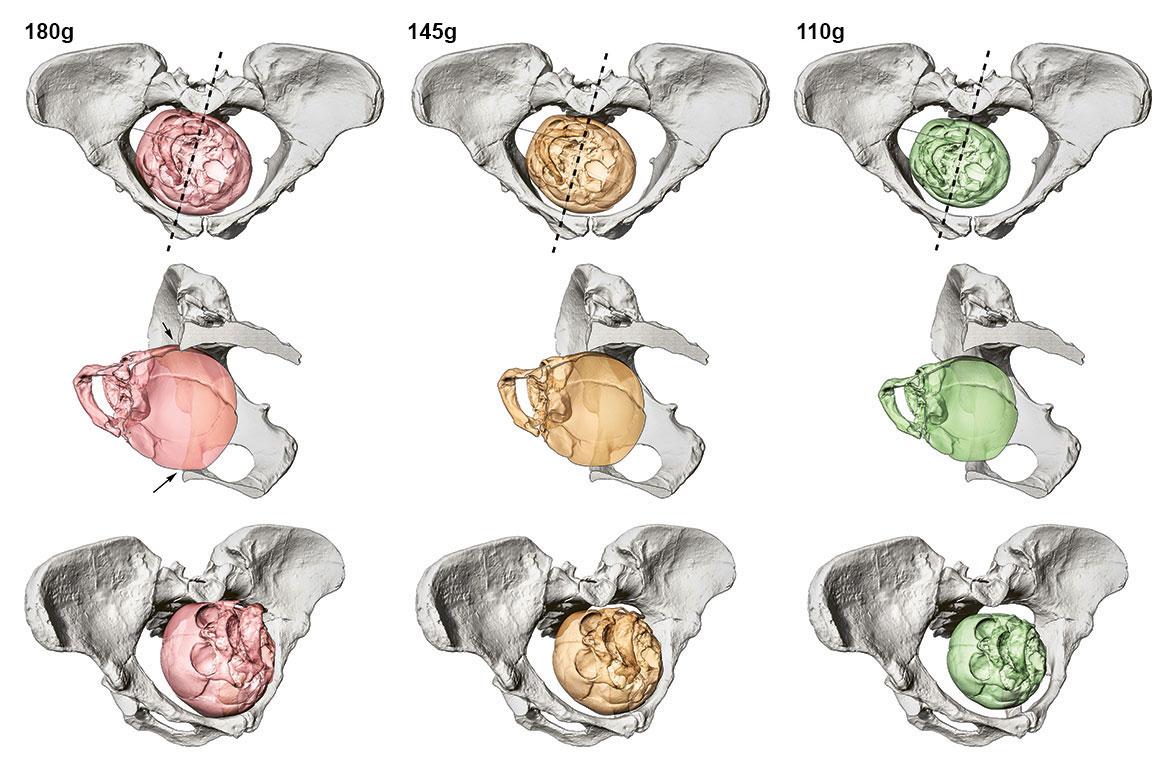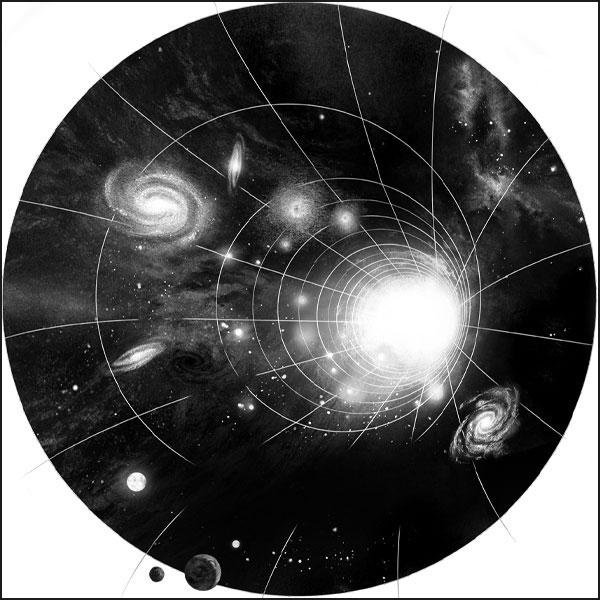HUMAN EVOLUTION
Lucy has a baby
Pre-human fossils millions of years old can provide hints as to why giving birth is so difficult for humans. The research methods developed to investigate this might prove useful in modern medicine.

A simulation of birth among pre-humans (Australopithecines) some three million years ago. To this end, researchers reconstructed the pelvic bone of the fossil known as ‘Lucy’. If the baby had a small brain (green), then its head would pass without a problem through the narrowest part of the pelvis (dotted line). However, if it had a large brain (red), its head would get blocked along the way (arrows). | Graphic: zVg
A few grams of brain can be crucial for the survival of Lucy’s foetus. If its brain weighs 110 grams, she should be able to give birth without any problems. If it weighs 145 grams, the baby would have to turn around considerably. At 185 grams, the head of the foetus would be definitively too big – the result of which would be the death of both mother and child, unless medical science came to their aid. But Lucy lived three million years ago in what is today Ethiopia. She’s one of the most famous fossils, and belonged to one of our earliest ancestors: the species known as Australopithecines.
These early hominids walked upright, though their brains were no bigger than those of chimpanzees. “But they already had ample knowledge of difficult childbirths”, says the evolutionary doctor Martin Häusler of the University of Zurich. A new study of his has now shone more light onto a mysterious phenomenon that also concerns humans today. Why, when compared to other primates, do we have the longest pregnancy, the most complicated births, and the most immature new-born babies?
This puzzle has traditionally been explained in part by an evolutionary conflict. In 1960 the anthropologist Sherwood Washburn brought together several different theoretical strands to form a single hypothesis that he named the ‘obstetrical dilemma’. When our ancestors began to walk upright, he believed, their pelvis became narrower over the generations because this is more efficient for walking on two feet. But this in turn created a disparity, because the brains of our foetuses were getting bigger and bigger. As a result, giving birth became increasingly difficult. There is a solution, however: our babies have to be born before their head becomes too big, which is why we are neurologically underdeveloped at birth. All the same, human births remain difficult.
Lots of explanations, but few facts
This hypothesis is disputed. For example, the anthropologist Holly Dunsworth has a different explanation for the birth of highly immature young among us humans. What’s decisive, she says, is not the difficulty of pushing the baby through the narrow birth canal, but the effort required to feed the foetus in the amniotic sac for longer than 39 weeks of pregnancy. The mother’s energy balance just couldn’t manage this for any longer.
The anthropologist and nutrition researcher Jonathan Wells takes a different view. He argues that it is primarily ecological factors that have determined both the size of the pelvis and the brain size of our offspring – namely the radical shift of humankind to agriculture some 11,000 years ago. Our carbohydrate-rich diet led to an increase in birth weight, he says, and at the same time to a shorter stature on the part of human mothers; this in turn meant a smaller pelvis.
“There’s just one problem with this theoretical debate”, says Barbara Fischer, an evolutionary biologist at the University of Vienna. “It is impossible to carry out an empirical study of how human birth has developed over millions of years”. Only a few fossils of our more distant ancestors are well-preserved enough to be of use in this. One of them is Lucy. Her partial skeleton was found in 1974. “But even here, there is a lot of room for different interpretations when you reconstruct the details”, admits Martin Häusler. “And in the past, researchers have tended to follow their own ideas instead of looking at the material in front of them”.
Simulating the birth process
New methods are now offering new possibilities, however. Häusler travelled to Ethiopia and South Africa himself in order to re-measure Lucy and two other Australopithecine finds. Using high-resolution surface scans and computer tomography, he was able to capture all the extant fragments in unparalleled detail as virtual 3D models. This has enabled him and his team to reconstruct the birth canals. “The big advantage of this procedure is that in a short space of time we can explore all the different possibilities of how the fragments might fit together”, he says. What’s more, every step his team takes can be verified precisely, which was not the case with earlier studies in this field.
Häusler can also go one step further by simulating the baby’s path through the birth canal. To this end he borrows the finite element method from biomechanics, for example, to calculate how artificial joints behave under pressure. Häusler’s team is thereby able to run through different scenarios using different assumptions about the rotational movements of the baby during birth and the baby’s brain mass. The average brain mass among Australopithecines – depending on the models they used – lay between 110 and 185 grams. This spectrum covers all possible individual head sizes. And within this spectrum, the researchers observed both simple and complicated birth processes. The distribution of these cases naturally depends on the assumptions made for the average brain mass, but it is clear that difficult births were more frequent among the Australopithecines than among those primates that did not belong to the line of descent resulting in humans.
Barbara Fischer finds this surprising. “Up to now, we assumed that this problem arose some one-and-a-half million years ago, when the brains of our ancestors began to get bigger”, she says. Häusler’s study now suggests that merely walking upright led to increased complications. This thereby lends weight to the ‘obstetric dilemma’ hypothesis, rather than other possible solutions. “Our findings could also suggest that social behaviour among humans started to develop before our brains began to grow”, says Häusler. “Because a difficult birth means others have to help”. This is unknown elsewhere in the animal kingdom.
Precise prenatal diagnoses
Naturally, Häusler’s research doesn’t explain everything. Fischer points out that there is only a small number of accessible fossils, which remains a problem: “Every new discovery can call current knowledge into question again”, she says. “But we always have to work with what we’ve got”. Nevertheless, Fischer sees the possibility of a concrete application for Häusler’s methodology – in obstetrics today. Her own research has involved comparing the form and size of women’s pelvises and the size of their heads. She has observed that women with a larger head also have a different birth canal that has adapted to the babies that these women might bear. Other studies have also found a considerable degree of variety in the form of birth canals. “Just as we can predict in retrospect which age-old fossils might have had especially difficult births, we might be able to predict these individually in the future too”, says Fischer.
Häusler is in fact developing his method in just this direction. “The next step will be to incorporate soft tissue into our calculations alongside the bones”, he says. “To this end we are working with gynaecologists”. Lucy’s retrospective ‘prenatal diagnosis’ could thus help pregnant women in future. But whether or not Lucy ever gave birth herself – and if so, how – will remain a mystery.




